|
|
|
 |

 |
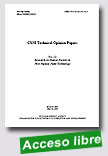 |
CSNI Technical Opinion Papers - No. 12: Research on Human Factors in New Nuclear Plant Technology
Nuclear Energy Agency (NEA), 11 Dec 09, 40 p.
It is a dynamic time for the nuclear power sector. Existing reactor control rooms are undergoing various forms of modernisation. New reactors are being built in many countries and advanced reactors are being designed through international co-operation to support power generation for decades to come. The new technologies and concepts that are being considered in this context could impact upon the roles of the plant operators and thus plant safety. It is therefore important that the potential
|
implications – both positive and negative – are evaluated and understood.
Through this technical opinion paper, the NEA Committee on the Safety of Nuclear Installations (CSNI) has sought to identify a set of research topics that should be explored in order to enhance knowledge of the human and organisational factors concerned. Research to address the topics described in this paper will provide the technical basis to help ensure that the benefits of new technology are realised and that the potential negative effects are minimised.
This paper should be of particular interest to research organisations and other stakeholders (including regulatory agencies, international organisations and industry organisations) that could support this research and benefit from its results.
Extraído de:
http://www.nea.fr/html/pub/ret.cgi?id=new#6844 |
 |
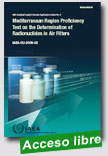 |
Mediterranean Region Proficiency Test on the Determination of Radionuclides in Air Filters
IAEA Analytical Quality in Nuclear Applications Series, 2009, 94 p.
The activity concentration of radionuclides in the air is a critical factor in assessing the air quality and the potential impact of possible pollutants. Air is in fact one of the main pathways for human exposure to pollutants. Radioactivity may be present in the atmosphere due to natural processes; intentional (low level) anthropogenic release; or as a consequence of nuclear or radiological incident.
|
Within the frame of the IAEA Technical Cooperation project RER/8/009 “Air Pollution Monitoring in the Mediterranean Region”, several Member States expressed their interest in establishing close cooperation among Mediterranean countries in the field of harmonization of air pollution monitoring systems and creation of a common database, since they share geographical position and mutual interest in the environmental conditions of the Mediterranean region. Such cooperation will also promote and enhance the exchange of experience/information.
Extraído de:
http://www-pub.iaea.org/MTCD/publications/PDF/IAEA-AQ-2_web.pdf |
 |
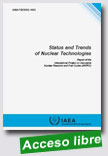 |
Status and Trends of Nuclear Technologies - Report of the International Project on Innovative Nuclear Reactors and Fuel Cycles (INPRO)
IAEA TECDOC Series, 12 November 2009, 49 p.
The International Project on Innovative Nuclear Reactors and Fuel Cycles (INPRO) was launched in the year 2000, based on a resolution by the IAEA General Conference (GC(44)/RES/21). INPRO intends to help to ensure that nuclear energy is available in the 21st century in a sustainable manner, and seeks to bring together all interested Member States, both technology holders and technology users, to consider, jointly, actions to achieve
|
desired innovations. INPRO is taking care of the specific needs of developing countries.
This IAEA publication is part of Phase 1 of INPRO (Refs [1–3]). It intends to provide an overview on history, present situation and future perspectives of nuclear fuel cycle technologies. While this overview focuses on technical issues, nevertheless, the aspects of economics, environment, and safety and proliferation resistance are important background issues for this study. After a brief description about the INPRO project and an evaluation of existing and future reactor designs the publication covers nuclear fuel cycle issues in detail.
Extraído de:
http://www-pub.iaea.org/MTCD/publications/PDF/TE_1622_Web.pdf
|
 |
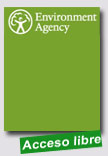 |
|
Substances Act (1993) and the Environmental Protection Act (1990).
In response to a request from the UK Government (following the Energy Review in 2006), designs for new reactor stations in the UK are assessed by the regulators following a process called the Generic Design Assessment (GDA). The GDA will essentially determine whether reactor designs satisfy the safety, security and environmental requirements for licensing and authorisation of nuclear power stations in the UK. As part of the GDA, the Environment Agency will assess the discharges to the environment from a new nuclear power station.
On behalf of the Environment Agency, AREVA Risk Management Consulting Ltd has conducted this study of actual discharges at operating nuclear power stations with reactor designs that are effectively precursors to the four generic designs submitted by vendors for GDA.
Extraído de:
http://publications.environment-agency.gov.uk/epages/eapublications.storefront/4b421ea902
ddd02c273fc0a80296067c/Product/View/SCHO0509BQAM&2DE&2DE# |
 |
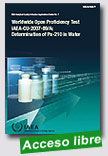 |
Worldwide Open Proficiency Test IAEA-CU-2007-09: A-Determination of PO-210 in Water
IAEA Analytical Quality in Nuclear Applications Series, 2009, 146 p.
The IAEA helps the Member States’ laboratories to maintain their readiness by coordination activities, by development of standardized methods for sample collection and analysis, and by conducting interlaboratory comparisons and proficiency tests as a tool for external quality control.
The Chemistry Unit of the Physics, Chemistry and Instrumentation Laboratory in the International Atomic Energy |
Agency’s Seibersdorf Laboratories in Austria, has the programmatic responsibility to support global radionuclide measurement systems. To fulfil this obligation and ensure a reliable worldwide, rapid and consistent response, the Chemistry Unit organises interlaboratory studies and proficiency tests.
The Po-210 poisoning event which occurred in November 2006 brought into focus a number of issues, including the capacity of laboratories to rapidly and accurately determine this radionuclide in environmental samples. A number of requests were received from Member States to address this issue. Responding to these requests, the Chemistry Unit of the Physics, Chemistry and Instrumentation Laboratory in the Agency's Laboratories, conducted a world wide proficiency test on the determination of Po-210 in water. The aim was to gather information on the current state of practice for Po-210 measurements at various levels in aqueous samples. This report describes the methodology employed and the results obtained in this proficiency test.
Extraído de:
http://www-pub.iaea.org/MTCD/publications/PDF/IAEA-AQ-7_web.pdf |
 |
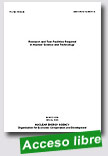 |
Research and Test Facilities Required in Nuclear Science and Technology
Nuclear Energy Agency (NEA), 09 October 09, 156 p.
Experimental facilities are essential research tools both for the development of nuclear science and technology and for testing systems and materials which are currently being used or will be used in the future. As a result of economic pressures and the closure of older facilities, there are concerns that the ability to undertake the research necessary to maintain and to develop nuclear science and technology may be in jeopardy.
An NEA expert group with representation from ten member
|
countries, the International Atomic Energy Agency and the European Commission has reviewed the status of those research and test facilities of interest to the NEA Nuclear Science Committee. They include facilities relating to nuclear data measurement, reactor development, neutron scattering, neutron radiography, accelerator-driven systems, transmutation, nuclear fuel, materials, safety, radiochemistry, partitioning and nuclear process heat for hydrogen production.
This report contains the expert group’s detailed assessment of the current status of these nuclear research facilities and makes recommendations on how future developments in the field can be secured through the provision of high-quality, modern facilities. It also describes the online database which has been established by the expert group which includes more than 700 facilities.
This publication is also available in French as: Besoins d'installations de recherche et d'expérimentation en sciences et technologies nucléaires - http://www.nea.fr/html/pub/ret.cgi?id=6849
Extraído de:
http://www-pub.iaea.org/MTCD/publications/PDF/Pub1254s_web.pdf |
 |
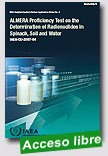
|
ALMERA Proficiency Test on the Determination of Radionuclides in Spinach, Soil and Water
IAEA Analytical Quality in Nuclear Applications Series, 2009, 134 p.
The Analytical Laboratories for the Measurement of Environmental Radioactivity (ALMERA) network established by the IAEA in 1995 makes available to Member States a world-wide network of analytical laboratories capable of providing reliable and timely analysis of environmental samples in the event of an accidental or intentional release of radioactivity. The
|
network is a technical collaboration of existing institutions. It provides an operational framework to link expertise and resources, in particular when a boundarytransgressing contamination is expected or when an event is of international significance.
A primary requirement of the ALMERA members is participation in the IAEA interlaboratory comparisons which are specifically organized for ALMERA on a regular basis. These exercises are designed to monitor and demonstrate the performance and analytical capabilities of the network members, and to identify gaps and problem areas where further development is needed. Continued membership has benefits in training and educational opportunities, enhanced mutual trust in results and methodology and objective evidence for accreditation purposes.
The performance evaluation results of the proficiency tests performed in the frame of the ALMERA network are not anonymous for those laboratories nominating to participate as ALMERA members.
This report describes the methodology employed and the results obtained in the
IAEA-CU-2009-04 proficiency test on determination of radionuclides in spinach, soil and water.
Extraído de:
http://www-pub.iaea.org/MTCD/publications/PDF/IAEA-AQ-3_web.pdf |
 |
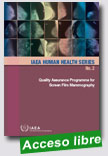 |
Quality Assurance Programme for Screen-film Mammography
IAEA Human Health Series, 2009, 221 p.
This publication establishes a detailed set of protocols concerning the application of radiation for medical purposes within the speciality of mammography. The publication addresses the requirements of a quality assurance programme which will allow an organization to optimize the conditions necessary to achieve the early detection of breast cancer and assure its successful treatment. To that end, the publication
|
contains details of actions needed to install and promote the quality culture, systematic programme of conduct and appropriate education that are critical for success. Instructional material to supplement the knowledge of professionals already working in this field is also provided, as well as quality control worksheets.
Extraído de:
http://www.berr.gov.uk/files/file53402.pd |
 |
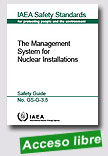 |
The Management System for Nuclear Installations
IAEA Safety Standards Series, 2009, 139 p.
This Safety Guide has been issued in support of the Safety Requirements publication on the Management System for Facilities and Activities, IAEA Safety Standards Series No. GS-R-3. It contains detailed recommendations in relation to nuclear installations, to complement the general recommendations provided in IAEA Safety Standards Series No. GS-G-3.1. This Safety Guide is applicable throughout the lifetime of a nuclear installation, including site evaluation, design, construction, commissioning, operation and decommissioning.
|
Contents: 1. Introduction; 2. The management system for nuclear installations; 3. Responsibility of management; 4. Management of resources; 5. Process implementation; 6. Measurement, assessment and improvement; Appendix I: Achieving the attributes of a strong safety culture; Appendix II: Management system for research and development activities for a nuclear installation; Appendix III: Management system for site evaluation for a nuclear installation; Appendix IV: Management system for the design of a nuclear installation; Appendix V: Management system for the construction of a nuclear installation; Appendix VI: Management system for the commissioning of a nuclear installation; Appendix VII: Management system for the operation of a nuclear installation; Appendix VIII: Management system for the decommissioning of a nuclear installation; Annex I: Example of a methodology for grading the application of management system requirements.
Extraído de:
http://www-pub.iaea.org/MTCD/publications/PubDetails.asp?pubId=8090
|
| |
|
|
|
| |
|
|
|
|
| |
|
|
|
|
|
|
